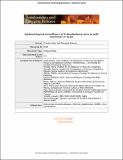Por favor, use este identificador para citar o enlazar a este item:
http://hdl.handle.net/10261/221642COMPARTIR / EXPORTAR:
 SHARE SHARE
 CORE
BASE CORE
BASE
|
|
| Visualizar otros formatos: MARC | Dublin Core | RDF | ORE | MODS | METS | DIDL | DATACITE | |

| Campo DC | Valor | Lengua/Idioma |
|---|---|---|
| dc.contributor.author | Jiménez-Ruiz, Saúl | es_ES |
| dc.contributor.author | Risalde, María Ángeles | es_ES |
| dc.contributor.author | Acevedo, Pelayo | es_ES |
| dc.contributor.author | Arnal, Maria Cruz | es_ES |
| dc.contributor.author | Gómez‐Guillamón, Félix | es_ES |
| dc.contributor.author | Prieto, Paloma | es_ES |
| dc.contributor.author | Gens, María José | es_ES |
| dc.contributor.author | Cano-Terriza, David | es_ES |
| dc.contributor.author | Fernández de Luco, Daniel | es_ES |
| dc.contributor.author | Vicente, Joaquín | es_ES |
| dc.contributor.author | García-Bocanegra, Ignacio | es_ES |
| dc.date.accessioned | 2020-10-23T07:58:52Z | - |
| dc.date.available | 2020-10-23T07:58:52Z | - |
| dc.date.issued | 2021 | - |
| dc.identifier.citation | Transboundary and Emerging Diseases 68(2): 347-354 (2021) | es_ES |
| dc.identifier.issn | 1865-1674 | - |
| dc.identifier.uri | http://hdl.handle.net/10261/221642 | - |
| dc.description.abstract | Schmallenberg disease (SBD) is an emerging vector‐borne disease that affects domestic and wild ruminants. A long‐term serosurvey was conducted to assess exposure to Schmallenberg virus (SBV) in all the wild ruminant species present in mainland Spain. Between 2010 and 2016, sera from 1,216 animals were tested for antibodies against SBV using a commercial blocking ELISA. The overall prevalence of antibodies was 27.1% (95%CI: 24.7–29.7). Statistically significant differences among species were observed, with significantly higher seropositivity found in fallow deer (Dama dama) (45.6%; 99/217), red deer (Cervus elaphus) (31.6%; 97/307) and mouflon (Ovis aries musimon) (28.0%; 33/118) compared to Barbary sheep (Ammotragus lervia) (22.2%; 8/36), Iberian wild goat (Capra pyrenaica) (19.9%; 49/246), roe deer (Capreolus capreolus) (17.5%; 34/194) and Southern chamois (Rupicapra pyrenaica) (10.2%; 10/98). Seropositive animals were detected in 81.4% (57/70; 95%CI: 70.8–88.8) of the sampled populations. SBV seroprevalence ranged from 18.8% (48/256) in bioregion (BR)2 (north‐central, Mediterranean) to 32.3% (31/96) in BR1 (northeastern or Atlantic, Eurosiberian). Anti‐SBV antibodies were not found before 2012, when the first outbreak of SBD was reported in Spain. In contrast, seropositivity was detected uninterruptedly during the period 2012–2016 and anti‐SBV antibodies were found in yearling animals in each of these years. Our results provide evidence of widespread endemic circulation of SBV among wild ruminant populations in mainland Spain in recent years. Surveillance in these species could be a useful tool for monitoring SBV in Europe, particularly in areas where wild ruminants share habitats with livestock. | es_ES |
| dc.description.sponsorship | This work has benefited from the financial aid of research grants funded by Spanish Ministry of Economy and Competitiveness (AGL2013‐49159‐C2‐2‐R, AGL2016‐76358‐R and CGL2017‐89866‐R). S. Jiménez‐Ruiz holds a PhD contract from the UCLM co‐supported by the European Social Fund (2018/12504). | es_ES |
| dc.language.iso | eng | es_ES |
| dc.publisher | Wiley-VCH | es_ES |
| dc.relation | info:eu-repo/grantAgreement/MINECO/Plan Estatal de Investigación Científica y Técnica y de Innovación 2013-2016/AGL2013‐49159‐C2‐2‐R/ES/EPIDEMIOLOGIA DE LA TUBERCULOSIS BOVINA EN ANIMALES DOMESTICOS EN ESPAÑA: IMPLICACION DE RESERVORIOS DOMESTICOS Y SILVESTRES Y EVALUACION DE MEDIDAS DE LUCHA/ | es_ES |
| dc.relation | info:eu-repo/grantAgreement/MINECO/Plan Estatal de Investigación Científica y Técnica y de Innovación 2013-2016/AGL2016-76358-R/ES/EVALUACION DE PROTOCOLOS DE BIOSEGURIDAD Y DE LA GESTION DE UNGULADOS EN LA TRANSMISION DE ENFERMEDADES COMPARTIDAS/ | es_ES |
| dc.relation | info:eu-repo/grantAgreement/MINECO/Plan Estatal de Investigación Científica y Técnica y de Innovación 2013-2016/CGL2017‐89866‐R/ES/CIUDADES RESILIENTES HABILITADAS POR LA INTERNET DEL FUTURO/ | es_ES |
| dc.relation.isversionof | Postprint | - |
| dc.rights | openAccess | en_EN |
| dc.title | Serosurveillance of Schmallenberg virus in wild ruminants in Spain | es_ES |
| dc.type | artículo | es_ES |
| dc.identifier.doi | 10.1111/tbed.13680 | - |
| dc.description.peerreviewed | Peer reviewed | es_ES |
| dc.relation.publisherversion | https://doi.org/10.1111/tbed.13680 | es_ES |
| dc.identifier.e-issn | 1865-1682 | - |
| dc.contributor.funder | Ministerio de Economía y Competitividad (España) | es_ES |
| dc.contributor.funder | Agencia Estatal de Investigación (España) | es_ES |
| dc.contributor.funder | Ministerio de Ciencia, Innovación y Universidades (España) | es_ES |
| dc.contributor.funder | European Commission | es_ES |
| dc.contributor.funder | Universidad de Castilla La Mancha | es_ES |
| dc.relation.csic | Sí | es_ES |
| oprm.item.hasRevision | no ko 0 false | * |
| dc.identifier.funder | http://dx.doi.org/10.13039/501100003329 | es_ES |
| dc.identifier.funder | http://dx.doi.org/10.13039/501100007480 | es_ES |
| dc.identifier.funder | http://dx.doi.org/10.13039/501100011033 | es_ES |
| dc.identifier.funder | http://dx.doi.org/10.13039/501100000780 | es_ES |
| dc.type.coar | http://purl.org/coar/resource_type/c_6501 | es_ES |
| item.openairetype | artículo | - |
| item.grantfulltext | open | - |
| item.cerifentitytype | Publications | - |
| item.openairecristype | http://purl.org/coar/resource_type/c_18cf | - |
| item.fulltext | With Fulltext | - |
| item.languageiso639-1 | en | - |
| Aparece en las colecciones: | (IREC) Artículos | |
Ficheros en este ítem:
| Fichero | Descripción | Tamaño | Formato | |
|---|---|---|---|---|
| epidemiospain.pdf | 773,45 kB | Adobe PDF |  Visualizar/Abrir |
CORE Recommender
SCOPUSTM
Citations
10
checked on 12-abr-2024
WEB OF SCIENCETM
Citations
7
checked on 26-feb-2024
Page view(s)
125
checked on 19-abr-2024
Download(s)
190
checked on 19-abr-2024
Google ScholarTM
Check
Altmetric
Altmetric
NOTA: Los ítems de Digital.CSIC están protegidos por copyright, con todos los derechos reservados, a menos que se indique lo contrario.
